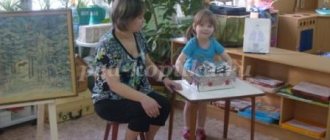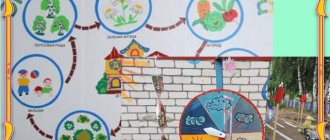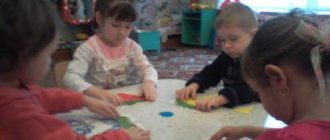Natural and man-made world. Lesson on familiarization with the objective world in the 2nd junior group
Familiarization with the objective world in the 2nd junior group Topic: “Natural and man-made world” Program content:
- Introduce children to the natural and man-made world.
- Encourage children to compose stories about nature using an algorithm.
- Define a generalizing word for a group of objects.
- Strengthen children's knowledge about the time of day.
Progress of the lesson: Children enter like a train - hold hands. - Stand around me, everyone. So we slept today, woke up, and what happened? (morning). Did you watch TV today? But I was listening to the radio, and you know what happened? (I stand at the table, take the microphone and speak in the voice of an announcer): - Attention, attention! There are two types of things missing: natural and man-made. Man-made - things made by man himself! Natural - created by nature. If anyone finds the items, please return them to their destination. (I leave the table). This is what they said on the radio today. Let's help you find things. Look, we have some things scattered around our group. Find and bring one item at a time. (children take pictures from the floor). Sit down on the chairs, we'll sort things out now. On one table there are things that are man-made, and on the other, things that are natural. - Attention attention! This thing that has sleeves, a fur collar, what is it? (fur coat), who made it? (man), what table will we put it on? (man-made world). - Attention! We need to find a small, beautiful one, with wings! Who is this? (butterfly) On what table? (natural). - Attention! You need to find leather ones, they put them on your feet, they have laces! What are these? (boots), did nature create them? Human. - Attention! You need to find something tasty, rosy, juicy, very tasty, it contains a lot of vitamins! This Apple). Who created it (nature). - Attention! You need to find a soft, fluffy one, he has 4 legs, loves milk very much, who is he? (pussy), is this the natural or man-made world? (natural). - Attention! You need to find a berry, black in color, large, compote and jam are made from it, what is it? (black currant), who created it? (nature). - Attention! You need to find a wooden object, it has 4 legs and a back. What is this? (chair), who created it? (man). - Attention! You need to find a very tasty, long, green vegetable, what is it? (cucumber), who created it? (man). - Attention! You need to find a very beautiful, delicate one, butterflies love to land on it, it has white petals and a yellow center, what is it? (daisy). Who created it? (nature). - Attention! You need to find an object, it is very large, it has a bottom and 2 handles, you can cook soup in it, what is it? (saucepan). Who created it? (man). - Attention attention! Radio Arkhangelsk speaking. We thank everyone who took part in the discovery of objects from the natural and man-made world! Well done guys, you helped find lost things.
Article Card index of summer conversations in the second junior group. Author: Irincheeva Svetlana Vladimirovna
CARD INDEX OF SUMMER CONVERSATIONS
IN THE SECOND JUNIOR GROUP
1. Conversation “What do we know about summer?” Goal: clarifying children’s ideas about summer; development of logical thinking and long-term memory.
2. Conversation “Vegetables and fruits are a pantry of health.” Goal: to consolidate children’s knowledge about the benefits of vitamins for human health. Inform children that vitamin A (tomato, carrot, onion, apricot..) improves vision; Vitamin C (cabbage, green onions, black currants, lemon) improves appetite.
3. Conversation “A variety of flowers.” Expand children's understanding of the variety of flowers: they can be large and small, round and flat, like bells and stars; they bloom on garden plants, shrubs, trees and herbs; Flower colors include all the colors of the rainbow.
4. Conversation “What is water for?” To develop children’s knowledge about the importance of water in human life; that water exists in the environment in various forms. These include rains, rivers, and seas. In rivers, the water is odorless, tasteless - fresh, pikes and crucian carp live in it... In the sea, the water is salty, and its inhabitants live there - jellyfish, sharks, dolphins and others. Foster respect for water.
5. Conversation about good and evil people. Goal: to reveal the essence of the polar concepts of “good” and “evil”, to show what emotional states they correspond to
6. Conversation “The sun is friend and enemy.” Goal: To form a system of ideas about the sun. Shining and warming are the main functions of the sun. But the sun does not always bring good things (burns, forest fires).
7. Conversation “Pets”. To consolidate children's knowledge about pets and their role in people's lives. To consolidate knowledge about the characteristic features of the appearance, behavior, and lifestyle of domestic animals.
8. Conversation “Forest House”. To give an idea that the forest is the green outfit of our planet. The forest can be coniferous or deciduous. Many plants grow here: shrubs, flowers, mushrooms. Reinforce the knowledge that the forest is a home for animals and birds.
9. Conversation “Air. What is he like? Goal: to consolidate the knowledge that air is what we breathe. It can be clean, fragrant, and sometimes it can be polluted, as in cities, from cars, factories, factories. The air has a smell.
10. Conversation “Beautiful Rainbow”. Goal: to arouse cognitive interest in children, to introduce the sequence of colors.
Memorizing the rhyme “Every hunter wants to know where the pheasant sits.”
11. Conversation “What do we know about insects?” Goal: to clarify children’s knowledge about insects, their diversity, to consolidate the concept of “health”; expand knowledge about preventive measures to prevent diseases and injuries.
children's ideas about summer, summer months; promote the development of agility and endurance.
12. Conversation: “Let’s go along the path into the forest.” Goal: to awaken interest in the forest and its inhabitants; introduce the rules of behavior in the forest and the rules for collecting berries and mushrooms; to arouse a desire to protect the forest and combat violations of the rules of conduct in the forest.
13. Conversation on the topic: “Summer games with children.” Goal: develop conversational speech and the ability to listen to your interlocutor.
14. Conversation: “What is good and what is bad?” Goal: To develop in children the ability to behave in accordance with the requirements of society.
15. Conversation: “How to avoid trouble?” Goal: To introduce the rules of behavior with strangers. Form the basic foundations of the safety of your own life.
16. Conversation: “Happy Summer.” Goal: To introduce children to summer activities and sports. Form ideas about safe behavior in summer.
17. Conversation: “Medicines and vitamins.” Goal: To familiarize children with the dangers of self-use of medications. Form in children the habit of not touching them without the permission of adults.
18. Conversation: “Mirilki.” Purpose: To introduce a variety of sentences - peace orders. Cultivate a desire to resolve conflict situations.
19. Conversation: “Microbes in human life.” Goal: To form children’s ideas about the dangers and benefits of microorganisms on human health. Teach the basics of a healthy lifestyle.
20. Conversation: “What grows in the garden, in the vegetable garden.” Goal: To summarize and systematize children’s knowledge about fruits and vegetables, where they grow, who cares for them.
21. Conversation: “Our little friends.” Goal: Expand children's understanding of insects, their characteristics, and habitats. Form the foundations of ecological culture.
22. Conversation: “Dangerous insects.” Goal: Expand children's understanding of dangerous insects. Learn to distinguish them by appearance.
23. Conversation: “Cleanliness is the key to health.” Goal: To familiarize children with the dangers of poor hygiene. Foster a love of frequency in children.
24. Conversation: “Such different mushrooms.” Goal: To introduce children to edible mushrooms (boletus, chanterelle, boletus) and poisonous ones (fly agaric, toadstool)
25. Conversation: “The bear has mushrooms in the forest, I take berries. Goal: To consolidate children's knowledge about seasonal changes in nature. Form ideas about forest plants: mushrooms and berries. Expand your understanding of the benefits of natural vitamins for humans and animals.
26. Conversation: “Forest dangers.” Goal: Expand children's understanding of poisonous plants. Learn to distinguish them by appearance.
27. Conversation: “Lake Baikal.” Goal: To form an idea of the lake, to cultivate a love for different regions, and a caring attitude towards the surrounding nature.
28. Conversation: “Animals of Lake Baikal.” Goal: To continue acquaintance of children with the inhabitants of Lake Baikal: seal, golomyanka, omul, goby; their appearance and lifestyle.
29. Conversation: “Plants of the Baikal region.” Goal: To form primary ideas about the flora of the Baikal region, about the plants of the mixed forest: cedar, birch, rowan, swimsuit (fry), Daurian rhododendron.
30. Conversation: “If you want to be healthy, toughen up.” Purpose: To introduce the concepts of “Hardening”. Expand children's understanding of a healthy lifestyle.
31. Conversation: “About fire safety rules.” Goal: to introduce children to fire safety rules.
32. Conversation: “Ground transport”. Purpose: To expand understanding of the types of ground transport and its purpose.
33. Conversation: “Water transport.” Goal: Expand understanding of the types of water transport and its purpose.
34. Conversation: “Air transport.” Goal: Expand understanding of types of air transport and its purpose.
35. Conversation: “Russian folk tales.” Goal: To teach children to draw a moral conclusion from the content of fairy tales.
36. Conversation: “Proverbs and sayings.” Goal: Getting to know proverbs and sayings. Introduce to Russian folk art.
37. Conversation: “Children’s folklore.” Purpose: To introduce chants and song appeals to the forces of nature.
38. Conversation: “About books.” Goal: to consolidate children’s knowledge about books; clarifying children’s knowledge about the purpose of books; develop the ability to compare and find similarities and differences.
39. Conversation “Magic words”. Goal: learn to be polite, say hello, say words of gratitude, say goodbye



